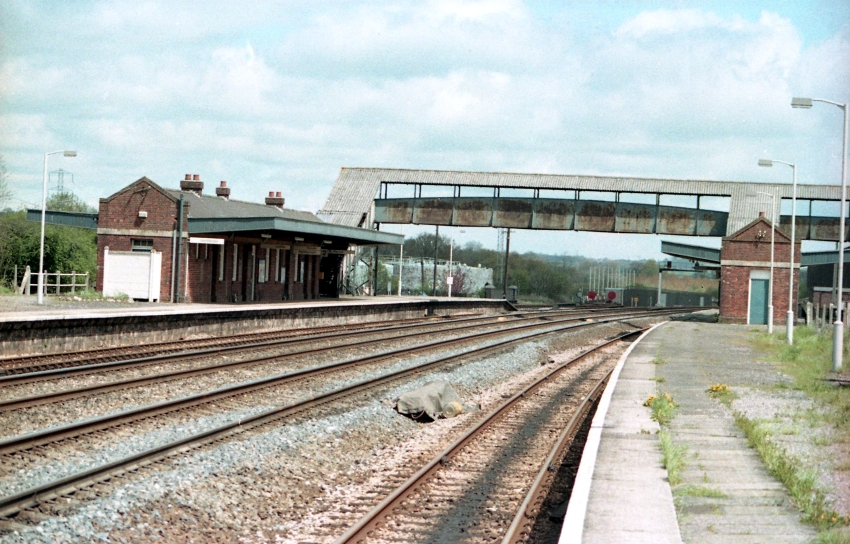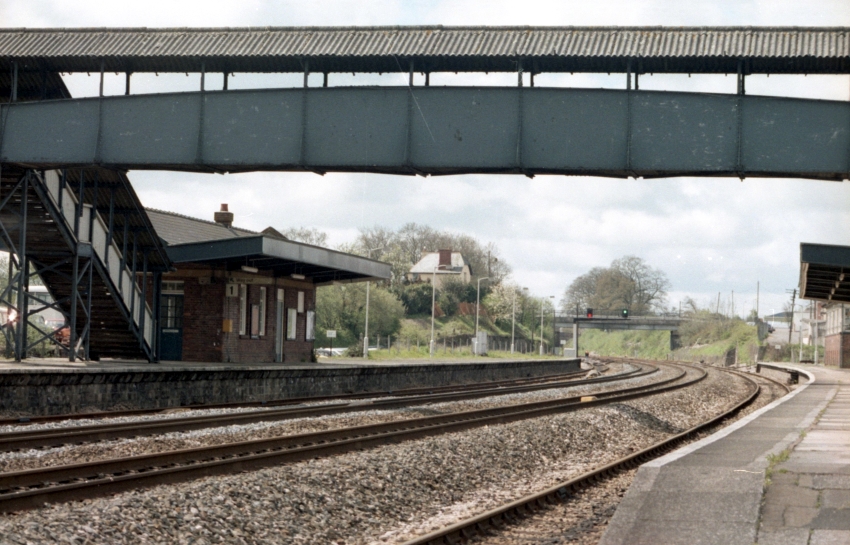Tiverton Junction
Two island platforms were now available, both being host to red-brick single-storey offices sporting upward-sloping canopies with plain timber valances. The outer platform faces of the islands – i.e. those which served traffic from the branch lines – had useable lengths of about half those serving the inner loops, and like the previous station, a covered footbridge linked these surfaces with the “down” side forecourt. The signal box was situated on the south western portion of the “up” island and was of a standard GWR design with red brick base, hipped slated roof, and horizontally-sliding windows.
The vast majority of sidings were concentrated south of the station, on the “down” side of the running lines; however, the goods shed was situated on the “up” side of the station, adjacent to the platform track of the Tiverton branch. As one of the photographs on these pages shows, the shed looked more like a platform canopy, comprising a pitched roof with timber valance, and lacked enclosed sides.
The replacement engine shed was built in the fork of the junction between the main line and Tiverton branch, like its predecessor, albeit on a new site marginally to the northwest and without the provision of a turntable. It was a single-track brick-built dead-end structure with timber doors and a pitched corrugated roof, and measured about 65-feet in length. The shed was sub to the depot at Exeter from the outset and typically had an allocation of two 1932-introduced 0-4-2 14xx tanks.
Being a modern GWR rebuild, the station changed little structurally in the British Railways (BR) era. The first act of the then newly-nationalised organisation was to brighten up Tiverton Junction with some new colours, after the dark days of war:
Brighter Railway Stations
Arrangements are being made for the following Western Region Railway Stations to be repainted this year: - Bridgwater, Wellington, Burlescombe, Sampford Peverell, Tiverton Junction. [Somerset County Herald, Saturday, 27th March 1948]
Naturally, the 1960s was a period of severe cutbacks. In Dr Beeching’s March 1963 The Reshaping of British Railways report, Tiverton Junction station and the branch line to Tiverton were recommended for closure. The branch line to Hemyock was already on BR’s proposed closure list even before Beeching had been hired. Public closure notices in local newspapers became a familiar sight during 1963:
British Railways Board – Public Notice
Transport Act 1962 – Withdrawal of Passenger Services
The Western Region of British Railways hereby give notice, in accordance with Section 56 (7) of the Transport Act, 1962, that on and from Monday, 30th September, 1963, they propose to discontinue all railway passenger services between Tiverton and Tiverton Junction and the following stations: - Tiverton, Halberton Halt.
It appears to the British Railways Board that the following alternative services will be available: -
By bus:
Service: Devon General Omnibus & Touring Co., Ltd.
Route: No. 3. Exeter – Tiverton – Halberton – Sampford Peverell.
Service: Western National Omnibus Co., Ltd.
Route: No.282. Taunton – Tiverton – Tiverton Junction – Cullompton.
It is proposed to amend the existing service as under: -
Western National Omnibus Co., Ltd. Service No. 282 3.40 p.m. bus Tiverton to Cullompton to be retarded to depart at 4.0 p.m. in order to cater for school children.
[Somerset County Herald, Saturday, 29th June 1963]
By June 1963, BR had confirmed that Tiverton Junction station would remain open, to be served by four main line trains in each direction daily, but the branch lines serving it would still be closed. The last day of passenger services on the Hemyock branch ran on Saturday 7th September 1963. Apparently, there were no objections from the local council, because passenger traffic was negligible. The branch had a claim to fame of being the slowest-booked passenger working in BR’s timetable, achieving an average speed of little under 15 MPH: “So slow, in fact, that the railways had to save a decrepit gas-lit coach from a Welsh siding to work on the line. Speeds were too slow to work an electric dynamo”. [Somerset County Herald, Saturday, 14th September 1963]
Goods traffic to Hemyock remained, however; a large dairy existed at the end of the line which, according to the Somerset County Herald, sent out thousands of gallons of milk by rail every day, and the roads were too steep and narrow in winter to switch this traffic to lorries. The same newspaper stated that a new diesel engine was to take over on the Hemyock branch the week after closure to passengers. Public goods traffic was formally withdrawn on the branch from 6th September 1965, but milk traffic continued to be sent by rail from Hemyock until October 1975, the dairy formally closing on 31st of that month.
As for passenger services between Tiverton and Tiverton Junction, these remained running for a year longer than the original proposed date of closure, ceasing to operate from 5th October 1964. The engine shed at Tiverton Junction closed at this time; it had been sub to the depot at Exeter (83C) from the outset, but briefly came under Taunton when the former closed in October 1963.
Public goods facilities ceased to be available at Tiverton Junction from 8th May 1967; however, by this time, a new freight traffic was handled at the site. North of the station, on the “up” side of the running lines, three private sidings had come into use – gated and fenced off from BR metals – to serve an Esso oil storage depot. This received traffic from the colossal refinery at Fawley, Southampton, and the oil sidings at Tiverton Junction were in place by 1957. In the book named Freight Trains of the Western Region in the 1980s (May 2021), it is noted that the oil depot here formally closed on 30th April 1983.
In combination with the re-signalling of the West of England mainline, closure of Tiverton Junction was sanctioned. It was proposed to replace the station with a new set of platforms located 1½-miles to the north, upon the site of the former Sampford Peverell Halt, the latter of which had been closed from 5th October 1964. Named “Tiverton Parkway”, the replacement station is situated alongside Junction 27 of the M5, and was primarily intended as a park-and-ride facility for those car users who did not want to drive into the centres of Exeter or Taunton. The new station came into use on 12th May 1986; from this date, closure of Tiverton Junction was effective, and semaphore signals gave way to colour aspect lights controlled from the then recently-commissioned signalling centre at Exeter St Davids.
After the station's closure the "down" siding beside the island platform, which was formerly part of the branch line to Hemyock, remained in use for the "Redland Tile Company". The March 1991 edition of the RCTS' The Railway Observer magazine reported that by late November 1990, this company had vacated the siding, all their wagons having been removed. Additionally, it was noted that planning application notices had appeared at the site, outlining the use of the same siding for incoming cement traffic.
In the June 1991 edition of the RCTS' The Railway Observer magazine, it was reported that demolition of the former station buildings started on 7th April of that year, followed by the footbridge on 14th of the same month. It was remarked in the same publication that the signal box had been demolished some time before this. The island platform surfaces remain in existence today.
10th July 1985

A northward view from the "down" island shows a large gap in the platform face underneath the signal box, from where rodding and cables emerged to link the cabin with the station's points and semaphore signals; all had less than a year of operation left. Since 1964, just two of the four platform faces commissioned in 1932 had been in passenger use. © David Glasspool Collection
15th May 1986

A second northward view shows the station a few days after closure. In the background can be seen then-recently commissioned colour light signals, alongside which remained the gated - albeit disused - oil storage sidings. The dark green of the canopy valances dated from late 1980; the canopies above those platform faces which no longer saw passenger services were still maintained. © David Glasspool Collection
15th May 1986

A southward view from just beyond the northern end of the "up" island platform shows that the through tracks were on a higher ballast level than the former platform loops. The footbridge looked in much better condition from this angle than the opposite side. © David Glasspool Collection
7th April 1998

Ex-GWR 14xx Class 0-4-2 No. 1450 is seen south of the former station site, on a movement which left Bishops Lydeard, West Somerset Railway, at 09:00 and is bound for Newton Abbot. This was in connection with the "Dawlish Donkey" steam shuttles between Exeter St Davids and Newton Abbot, organised by "Past Time Rail". It is evident that by the time of this photograph, the former platform loops had been extended further south; previously, the connections with the main running lines were nearer the bridge in the background, beyond the latter of which can be seen the still extant "up" island. © David Glasspool Collection
Return to the Kent Rail Homepage or alternatively, check for Updates.
Website & Copyright information - Links - Contact the Webmaster
